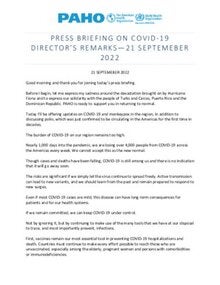Press Briefing on COVID-19: Director's Opening Remarks, September 21, 2022

|
Good morning and thank you for joining today’s press briefing. Before I begin, let me express my sadness around the devastation brought on by Hurricane Fiona and to express our solidarity with the people of Turks and Caicos, Puerto Rico and the Dominican Republic. PAHO is ready to support you in returning to normal. Today I’ll be offering updates on COVID-19 and monkeypox in the region, in addition to discussing polio, which was just confirmed to be circulating in the Americas for the first time in decades. The burden of COVID-19 on our region remains too high. Nearly 1,000 days into the pandemic, we are losing over 4,000 people from COVID-19 across the Americas every week. We cannot accept this as the new normal. Though cases and deaths have been falling, COVID-19 is still among us and there is no indication that it will go away soon. The risks are significant if we simply let the virus continue to spread freely. Active transmission can lead to new variants, and we should learn from the past and remain prepared to respond to new surges. Even if most COVID-19 cases are mild, this disease can have long-term consequences for patients and for our health systems. If we remain committed, we can keep COVID-19 under control. Not by ignoring it, but by continuing to make use of the many tools that we have at our disposal to trace, and most importantly prevent, infections. First, vaccines remain our most essential tool in preventing COVID-19 hospitalizations and death. Countries must continue to make every effort possible to reach those who are unvaccinated, especially among the elderly, pregnant women and persons with comorbidities or immunodeficiencies. This is especially true in the Caribbean, where a number of islands continue to lag behind in vaccination coverage. Second, it is important that we continue to track and report both COVID-19 cases and vaccination progress. Member states must update their national dashboards regularly or share this information with PAHO, so that we can target our efforts where they are most needed. In the last few weeks, we have seen countries relaxing on vaccination data reporting. This brings to mind my third point: public health measures. Member States must act wisely and continue to promote these practices in places where many remain unvaccinated, or where cases are climbing. Beyond COVID-19, monkeypox cases are still rising in parts of our region. Overall, we have seen an increase of over 23% in confirmed cases in the Americas in this period. PAHO has supported the expansion of testing capacity and 31 countries and territories are now able to identify and report cases of monkeypox. So far, our region has registered five deaths due to this virus. These deaths remain extremely rare, but it is critical to remember that people with weakened immune systems are at risk of complications from monkeypox infection. Of course, countries must act now to control the spread of monkeypox. Active engagement of affected communities, testing and contact tracing can all have a significant impact in reducing transmission. Especially while vaccine supplies remain very limited. Lastly, and very seriously, I would like to address a disease I never expected to see in our region again. I am referring to polio. In July, an unvaccinated man was reported paralyzed by poliovirus in the United States. In the weeks since, polio was found in wastewater samples in several counties, including New York City, triggering a disaster declaration from the Governor of the State of New York. And last week, the virus was indeed found to be circulating through these communities, officially constituting an outbreak in the region. It’s been nearly 30 years since the Americas became the first global region to wipe out wild polio, thanks to comprehensive and coordinated vaccination campaigns. But dwindling vaccination rates, worsened by the COVID-19 pandemic, have left many of our populations unprotected. Let’s be very clear - polio is not a treatable disease. Prevention is the only option. And prevention is only possible with vaccines. As we saw in New York State, poliovirus can appear and spread quickly and quietly in communities with insufficient vaccine coverage. And today, polio vaccination coverage is below 80% in nearly all of South America. 12 countries in our region are at High or Very High risk of experiencing an outbreak. I don’t have to stress that this is a serious problem, and one for which we have a clear solution: Immunization with a polio vaccine provides complete protection against polio infection. Let me commend the United States for its swift public health response. Disease surveillance has been intensified. Polio immunization campaigns are targeting those who may not have received a complete vaccination series against polio. And public health messaging is reaching at-risk communities in their own languages. PAHO is in close contact with the United States, and we have issued several alerts to Member States so that they remain vigilant. I really cannot state this strongly enough: we urge all countries in the region to strengthen surveillance and proactively reach the unvaccinated with polio vaccine. PAHO has alerted all Heads of States of the Region with regards to the risk and the threat and the need to catch up on polio immunization as a matter of urgency. We must not take the lifesaving power of vaccines for granted. On another note, next week, I will have the honor of joining Ministers of Health from across the region at the 30th Pan American Sanitary Conference. A landmark event that brings together the health leadership of our region every five years. This is an opportunity to look back and learn from the challenges that the Americas have faced over the past few years. But, more importantly, it is an opportunity to look towards the future and our vision of a more equitable region, in which we work together to improve health for all. Thank you. |
